Lacerations (Tear/Tear/Rise/Fire) 절상
Overview of lacerations
In most cases, prior to the first emergency treatment by a doctor for injuries such as burns, cuts, lacerations, etc. that occurred to children and adolescents, take first-stage emergency treatment at the site of the accident in which the were injured, such as burns, cuts, lacerations, etc.
It is common to have priority first.
Then, catch-up (tracking) treatment is carried out by parents at home according to the doctor’s telephone treatment instructions, parents do catch-up treatment on their own without the help of a doctor, or go to the Pediatrics Department to receive catch-up treatment or emergency medical treatment.
It is common to go to and get catch-up treatment there.
Here, we will explain how to manage acute cutaneous wounds (Acute cutaneous wounds management) at the first stage that can provide emergency treatment at the site of an accident in which children and adolescents have injured injuries.
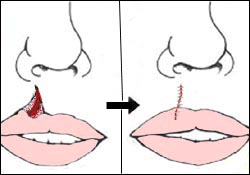
▴ Figure 1-14. Lip laceration (left) and before receiving suture surgery Lip laceration after suture surgery treatment (right). Copyright ⓒ 2011 John Sangwon Lee, MD., FAAP
Laceration causes
A knife, a razor, a piece of glass, or other types of sharp objects cuts the entire skin layer, subcutaneous tissue, muscles, blood vessels, peripheral nerves, etc. It is called a laceration.
Lacerations can also occur in the skin layer and, or subcutaneous tissue.
Lacerations can occur in one organ of any of the various systems of the body, such as the brain and liver, or in some tissues of several organs.
Lacerations are more likely to occur on body parts such as the face, limbs, or limbs that are most exposed to the outside.
Laceration can be caused by traffic accidents or safety accidents, etc.
Only lacerations may occur separately and may occur simultaneously with bruises, abrasions, or cuts.
When lacerations occur on the entire skin layer and subcutaneous tissue, they can be easily seen with the naked eye, so it is easy to diagnose that there is a laceration.
Since lacerations in internal organs such as the liver, kidney, spleen, or brain cannot be seen with the naked eye without surgery, it is difficult to quickly diagnose whether lacerations have occurred in the internal organs of the body.
[Parents should also be at least the half-doctors-Encyclopedia of Child and Family Nursing]-Volume 2 Prevention of Child and Adolescent Disease Safety Accidents-General Prevention, Volume 21 Child and Adolescent Home Nursing-Betadine solution disinfectant, skin hydrogen peroxide disinfectant, disposable band-aid.Symptoms sign of laceration

Symptoms, diagnosis, and treatment differ depending on the severity, cause, and part of the body where the laceration occurred.
If the laceration is severely sized, the blood vessels, muscles, and peripheral nerves in the laceration wound may be amputated, and symptoms of laceration may differ depending on the extent of the cut.
When a severe laceration occurs in an organ deep in the body, large and small blood vessels, nerves, etc. may also be cut, internal bleeding may occur, and nerve paralysis may occur.
Sometimes, both internal and external bleeding can occur simultaneously.
Severe internal and external bleeding can lead to shock and death.
If the peripheral nerve is cut due to the laceration, the nerve at the end of the body part where the laceration has occurred can be paralyzed.
The laceration wound is usually swollen and painful.
Large lacerations in organs or tissues can cause dysfunction of the organs or tissues.
In almost all cases, laceration wounds fester easily if they are not properly treated.
Infectious diseases may occur due to the festering of the laceration wound easily due to bacteria easily infected by the bacteria on the lacerations that are dirty, lacerations with dirt, lacerations containing foreign matter, lacerations that have not been properly treated, and symptomatic symptoms may occur accordingly.
In particular, lacerations around the face, lips, hands, external genital organs, mouth, and orbits may cause dysfunction of the body part that received the laceration even after treatment and may cause cosmetic problems.
You need to see a specialist who knows better about the treatment of lacerations in those areas.
Laceration treatment
The symptoms of lacerations differ depending on the part of the body, such as the face, lips, mouth, nose, ears, scalp, and neck where the laceration has occurred, and the treatment is different.
Depending on the dysfunction of the area caused by the laceration, the symptoms of lacerations differ and treatment methods are different.
The following mainly describes the treatment of lacerations in the skin layer and subcutaneous tissue.
Laceration size,
How long has passed since laceration?
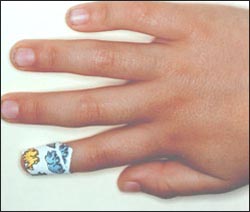
▴ Photo 60. Small, not deep, and not severe lacerations
Disinfection after sterilization with betadine solution disinfectant
It can be treated by covering it with a band.
Copyright ⓒ 2011 John Sangwon Lee, MD., FAAP
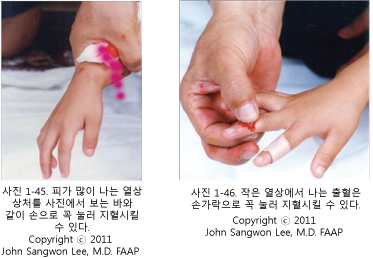
The treatment method differs depending on the complications caused by laceration wounds, and lacerations cannot be treated uniformly.
It stabilizes the child who suffers from lacerations and is embarrassed.
Bleeding from a laceration wound is stopped with pressure by a finger, hand, finger, tourniquet, or band.
Ask for help from people around you as needed.
Start the first emergency treatment at the accident site according to the instructions of a medical paramedic, hospital emergency room, or regular pediatrics and adolescents department.
When performing the first emergency treatment for lacerations that have penetrated through the clothes you wear, take off your clothes carefully, or cut off your clothes with a knife or scissors, and then carefully examine the lacerations and provide emergency treatment.
You can carefully remove any foreign matter from the surface of the laceration wound.
If possible, a doctor will remove any dirt or objects that are deep inside the laceration wound.
According to the doctor’s instructions, the father and mother can also remove objects or dirt from the laceration wound at the scene of the accident.
The bleeding from the laceration wound is stopped by pressing the laceration wound directly with the tip of the finger.
Large laceration bleeding that occurs very severely can be stopped by pressing the laceration wound with the palm of the hand, stopping the bleeding with a tourniquet, or by pressing firmly on the part of the body where the artery that supplies blood to the laceration wound is held.
You can stop the bleeding by raising the affected body part higher than other parts of the body.
Small lacerations cut with dirty knives or pieces of glass, etc., should be washed thoroughly with sterilizing soap water, or sterilized by washing with betadine solution disinfectant.
Depending on the size and extent of the laceration, treat the laceration by covering the laceration with a disposable band-aid or Dermabond, cover the laceration with sterile gauze and wrap the gauze with a bandage, or wrap the covered sterile gauze with a band-aid for treatment.
Small lacerations on the surface of the skin layer are washed with clean water and bleeding.
You can apply antibiotic ointment to the laceration wound and cover it with a disposable band-aid for emergency treatment.
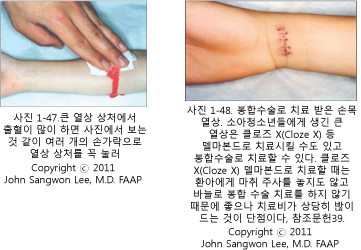
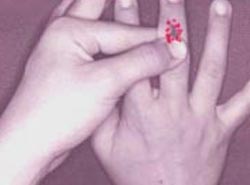
▴ Photo 1-49 Bleeding from small incisions
You can stop bleeding by pressing.
Copyright ⓒ 2011 John Sangwon Lee, MD., FAAP
If the laceration wound is large or deep, or the wound edge of the laceration skin layer is wide open, suture surgery is required.
When lacerations occur for these or other reasons, in most cases, it is most ideal to receive treatment at a hospital or according to the doctor’s telephone instructions.
In general, lacerations with a length of less than 3mm, simple torn, clean cuts, and lacerations on body parts such as limbs, hands, feet, head, and torso are cleaned by parents at home with soapy water and used as a betadine disinfectant.
Either sterilization treatment may be performed, or sterilization may be performed with only betadine solution disinfectant without washing with water, and the laceration wound may be covered with a disposable band-aid for treatment.
Depending on where the cut occurs in the body, depending on the presence or absence of complications, the treatment method for cuts is different, but appropriately treated cutaneous cuts usually heal naturally after about 4 to 5 days. Larger, bleeding and poorly treated wounds are more likely to cause larger scars after treatment and may lead to cosmetic problems in the future.
In particular, large incisions on the face or hand should be treated with suture surgery.
Although the treatment method for resections differs depending on the part of the body where the resection occurs or the child’s age, etc., in general, incisions larger than 3mm in length are treated with suture surgery.
It is common for scalp incisions larger than 3mm to heal well even without suture surgery.
It is common to remove the stitches for incisions in the limbs 6 to 8 days after receiving suture surgery, and 5 days after receiving suture surgery for incisions on the face or scalp.
Incisions that have not been treated with suture surgery or incisions received with suture surgery can sometimes fester.
If the cut is festered, the cut may become swollen, red, painful, and blood pus may appear.
When the wound is festered, it is treated with appropriate antibiotics depending on the degree of festering.
Nowadays, instead of treating simple incisions with suture surgery, local skin adhesives (eg, Cyanoacry topical skin adhesives), Delmar Bond, and surgical tapes are used to treat incisions.
Treatment in this way makes it easier to treat in a short period of time and does not hurt more than when undergoing suture surgery (source; NEJM Sep 2008 p.1037).
If you are wounded, you should be vaccinated against tetanus with a tetanus vaccine as needed.
When the cut wound is dirty, you can receive prophylactic treatment with antibiotics to prevent festering due to bacterial infection.
To summarize the treatment of lacerations,
Where the laceration occurred on the body, How dirty the laceration is, Whether there is a foreign matter or dirt on the lacerations, In consideration of future aesthetic issues, etc.
Whether the parents will perform the first emergency treatment at home, Decide whether to receive suture surgery treatment at the hospital emergency room, regular pediatrics department, or local surgeon, or treatment with
Delma Bond
.
The following is an example of the online pediatric and adolescent health counseling question and answer on
“Please tell me how to treat lacerations, scars, and wounds on my face.”
Q & A.
Please tell me how to treat lacerations, scars, and wounds on the face.
Q.
Today, my 6-year-old daughter was drawn with a 5cm pencil under her eyes and her blood came out.
First of all, I applied’ Fushidin’ and I was so sick and worried that her scar would remain, so I asked her around and said that there is a medicine that does not leave scars.
So she took it to the pharmacy and asked, “I know the wound is very deep,” and she recommended that it is “mink oil”. Only a cosmetic sample bottle costs 8,000 won…
They say it’s effective, but I want to try it first.